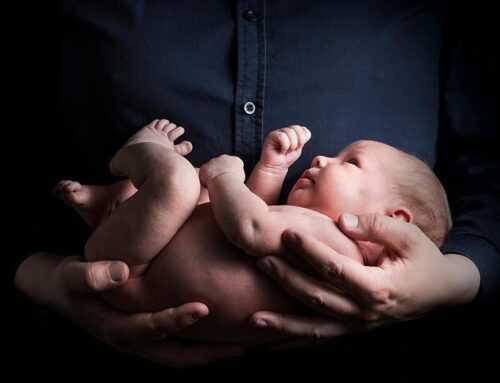1. Introduction
As soon as possible after birth, and no later than 72 hours after birth, a thorough physical examination will be carried out. This will include checks of the eyes, heart, hips and, for boys, the testes. If there are concerns after these checks, your child will be referred for further help and support. Your midwife will also discuss antenatal and newborn screening – which includes the very important newborn blood spot (heel prick) test and the hearing screen – with you, explaining why they’re offered and what’s involved. If it’s a first baby, the midwife will also calculate the risk of the baby becoming jaundiced between 48 and 72 hours after birth and recommend having the blood spot test carried out before the baby is 24 hours old.
In the early weeks of life, a baby will have many checks to assess wellbeing and to detect problems, as early treatment for some problems is more effective when done early on. Here’s what to expect from newborn checks – including vaccinations – until your baby is 6 to 8 weeks old after their birth.
1.1. Purpose of Newborn Checks
As there is increasing recognition of the importance of attachment and bonding between the new parents and their baby, the timing, location, and process of the newborn checks have been reviewed and adjusted, and these checks are usually combined with the parental review, preferably during a recommended time window. In less busy times or under some arrangements, families may also arrange additional postnatal appointments with the family doctor. In some areas or after home births, the community midwife or a community postnatal review is required to give advice and support for the newborn baby, by referring the baby to the family doctor or health visitor. Back-referral of the baby to the family doctor after discharge is essential for the baby to receive GP and health visitor checks. Back-referral can be done via handover of care from the hospital to the follow-up provider or by the parents making their own arrangements for a postnatal appointment after discharge. The arrangements should be confirmed before discharge, and the family should be provided with a clear care plan and instructions about back-referral. In England, the Scottish Government, the Welsh Government and the Health and Social Care Board, and NHS Health Scotland have published guidelines and standards outlining the care that should be provided to women and babies. These reflect the research findings of the National Institute for Health and Care Excellence, the Nurse Family Partnership, the World Health Organization, and the National Childbirth Trust, in coordination with the Institute of Health Visiting, the Royal College of Paediatrics and Child Health, the Royal College of General Practitioners, the Royal College of Midwives, and the Royal College of Nursing. The purpose of this newborn review will be to identify if the baby has any of the assessed conditions, to provide advice and differentiated referrals, to ensure that the baby’s general health and wellbeing are assured and, importantly, to check that breastfeeding is properly established. To ensure promotion of general health and safety, observation and discussions should include the baby’s security, safety, alertness/NIPS score, feeding, hygiene, hypoglycemia, growth, hydration, infection, jaundice, nappy rash, pigmentation, reflux/posseting, skin and eye contact, treatment administration, umbilicus, vital signs, weight, and dressing of the mother. Although the results of the newborn review are generally reassuring, this multi-professional selection of checks also ensures comprehensive assessment of the health of the baby and prepares the family for what to expect during the postnatal period.
To ensure prevention and timely support, the care pathway for neonatal prevention includes weighing, breastfeeding support, vitamin K administration, vaccination, and screening tests for early identification and intervention. Such regular assessment of the baby’s growth and development in early life through regular newborn checks is important to help spot any problems such as developmental hip dysplasia or hearing impairment at very early stages. Health screening for the baby, information and support for the family, and an opportunity for families to express their anxieties help to enhance the family’s ability to respond to the baby’s needs. The arrangements for this newborn check in different countries and regions vary, depending on the context and the models of maternity care, but it usually involves back-referral of the baby to the primary care provider after discharge from the hospital or the maternity facility, so the care provider can check the baby’s progress and assess the baby’s development in the early days, and continue monitoring the baby’s growth and development over the first few months of life.
2. Physical Health Checks
In the first few days after birth and up to the ages of 4-8 months, the shape of your baby’s head will be changeable. This is because your baby’s skull bones have not yet completely joined and will still move about. In some babies, the back or one side of the head can become flattened, and this is what the doctor will check your baby’s head for. It generally happens because the baby lies on the back, and actually, this is a good thing because it reduces the risk of Sudden Infant Death Syndrome. To keep your baby’s head round, give him/her plenty of time on the tummy when awake. A flattened head will generally sort itself out by the age of 12-18 months, but if your baby’s problem seems to be taking a long time to improve, you should seek advice.
At each health visit up to the age of two, your baby’s doctor will check for certain physical development signs. This article will help you understand the things that your doctor will particularly look out for and give you an idea of what treatments or exercises your baby’s doctor might suggest. Today we’re focusing on physical development markers for all babies.
2.1. Weight and Height Measurements
While weight and height measurements are not clinical checks, they are vital for monitoring a baby’s development. Nutritional status is reflected by how well a baby is growing; if a baby is not gaining weight, this may indicate feeding or other health problems. Regular weight gain in the early days can provide reassurance that the baby is feeding well and does not have feeding issues which may have a long-term impact on growth and development. In the United Kingdom, these measurements also form part of how happy a baby health visitor or other healthcare professionals are with the baby’s continuing health. It is important that weight is measured and plotted against the growth chart in exactly the same way each time to ensure consistency and accuracy. Changes in factors such as what the baby is wearing or large amounts of winding can all affect the measurement and so standardizing the measurements should ensure it is only the baby’s weight which influences the plotted pattern.
3. Neurodevelopmental Assessments
About 11% of children have strabismus. Prism adaptation studies have shown that binocular misalignment diminishes and may even resolve with treatment. The developing visual system is most plastic in the first 6 months of life and very little plasticity remains by age 1 year. Infants are usually asymptomatic and do not experience diplopia. Strabismus is recognized to be a manifestation of pathology along the visual neural pathway that begins at the retina and includes the optic nerve, chiasm, tract, radiation, and cortex. Strabismus disrupts normal visual fields. Insufficient deep binocular vision and discomfort from straining one of the two lid muscles referred to as becoming comfortable may explain intermittent strabismus and discomfort. Forty to fifty percent of patients may have a genetic predisposition for strabismus. Brain imaging studies have demonstrated the loss of cortical binocular columns in four of three patients with loss of binocular vision. Brainstem MRIs are abnormal in forty patients with early-onset strabismus suggesting that brainstem and peripheral differences may temper the preferred gained patterns of eye movement. Infant acuity testing is difficult to standardize and has limitations of testability. Current American Association for Pediatric Ophthalmology and Strabismus, American Association for Ophthalmology, and the American Academy of Pediatric guidelines do not formally recommend routine vision screening for photopic and microscopic vision in children below the age of 3-4 years.
Conventional, early standardized neurodevelopmental assessments performed in the newborn period may detect those at high risk for adverse outcomes who would benefit from early intervention. Early detection and intensive early intervention programs may lead to improved clinical outcomes and are more cost effective. Unfortunately, most current evaluations of newborns are used for diagnoses of disease and visual examination focuses on the external newborn eye. These clinical examinations do not address the wide range of pre-cortical processing that is the foundation for central level vision, fixation and pursuit, saccades, smooth pursuit, optokinetics, and stereopsis. These systems are not mature in the newborn period but are tractable to treatment.
3.1. Reflexes and Motor Skills
At the four to six-month stage, the baby is usually showing good head control and readily moving their arms and legs. Over the next six months, they will use their arms to lift themselves from lying to sitting. At six to eight months, they often sit alone, then roll, and by eight to ten months, they will often pull themselves to stand and cruise around holding onto the furniture or by ten to 12 months walking first with support and then unassisted. At 12 to 18 months, most children can walk confidently. Of course, different babies develop skills at different rates.
There are many reflexes in a newborn baby, and these are usually at their peak in the first four to six weeks. Some of these reflexes are: the Moro reflex—soon after birth, a baby will throw out their arms, unfurl the fingers, and clench the fists if they are startled; the grasp reflex—this is where a baby’s hand closes if an object is placed in their hand. The rooting reflex—when a baby’s cheek is stroked, they will turn their head, open their mouth, and search for the nipple. The Babinski reflex—is when the baby’s big toe rises and the other toes fan out when the baby’s foot is stroked.
4. Sensory Screenings
The screening for vision uses techniques that enlist reflectance (red reflex) of light from the retina. This ability determines the loss of vision for already sensible light quantities, for example, when affected by images of the retinal nerves. When the red reflex is not symmetrical, it may be sought for causes such as asymmetric refraction, cataracts, corneal opacities, glaucoma, microphthalmia, vitreous hemorrhage, lens subluxation/dislocation, retinoblastoma, retinal detachment, or retinopathy arising posterior to a simple longitudinal grip. For some of these, like retinoblastoma, it is urgent to locate and treat the cause in no more than a week or two. Otherwise, blindness could be settled and/or the tumoral cells could spread. When not symmetrical and not arising from a simple angulation of the body, the reasons are signs of opacities arising in the eyes. This is why regular medical evaluations of all organs are imperative for newborns.
Since newborns are not subjected to specific sensory stimuli and do not talk, the hearing screening is performed routinely using a brainstem response test. This test is reliable, without known side effects, and considered not to be painful or stressful.
The first test is for sensorineural hearing loss (deafness). The results of the test may categorize the baby as needing further examination or not. The results are then clearly and unambiguously normal (refer rate of 1.5%, which happens, for instance, for false positive screening) or abnormal. Having a reasonable level of confidence in the results is also important since better results with the same screening test are expected to lead to better care and treatment of children identified with a permanent moderate-severe auditory loss.
Sensory screenings for newborns consist of hearing and vision tests. There are two essential tests for newborns to prevent treatable permanent impairments caused by sensory difficulties that are not diagnosed or are diagnosed late due to lack of obvious symptoms. These impairments could lead to motor, emotional, social, and cognitive delays and limitations.
4.1. Hearing and Vision Tests
It is very important to test for these three things not only for those at risk because of the problems above but also for the other mum and dad-baby pairs who may have problems but who did not have the risk factors.
– Low birth weight – Being born prematurely – Postnatal illness such as severe jaundice, brain bleed, infection, and – Long stays in the hospital.
Small newborns are more likely than larger ones to have health problems during their first years of life. Their immature body systems may not be well developed, so they are more likely to have problems with their hearing, vision, or motor development. Additionally, some risk factors which appear to be related to a baby’s development are more common in small babies. These include:
Some states provide hearing tests for newborns so that they can be treated straight away if there are any major problems. Most babies can see very well soon after they are born — but many need to see a baby health clinic doctor to have their eyes checked. If the doctor thinks there might be a problem with the structure of the baby’s eye, they will be referred to an eye doctor. Most babies can see OK, but if there is a vision problem, it is good to find out early so it can be fixed. Most three-month-old babies can see well unless there may be a problem with the vision. All babies, whether they appear to have good hearing and vision or not, should be watched carefully for signs of any developmental or sensory impairment during the first two years of life, and if anything bothers the parents, they should seek advice straight away.
5. Conclusion
Acupuncture or spinal manipulation for individuals of all ages act as a preventive health service that promotes positive parent engagement and education. The checklist below is adapted from the Parent’s Guide to Baby’s First Six Months by the KK Women’s and Children’s Hospital, a specialty hospital in Singapore.
Regular and periodic routine newborn checks during the first six months of a baby’s life are strongly recommended to ensure that the baby’s health and developmental needs are attended to in a timely manner. They serve as an important guide for parents to keep track of their baby’s growth and physical development, as well as to understand their needs and interact positively with them.
4th Month: – Turns around completely when lying on back – Raises head to 90 degrees when lying on stomach – Grasps object with all fingers.
3rd Month: – Supports head well and begins to play with hands and objects that he/she holds – Grasps and holds a rattle for a few minutes.
2nd Month: – Starts to develop a social smile – Becomes more outwardly-directed by watching faces and cries to communicate discomfort unless picked up or soothed – Moves eyes and head to look around when placed on tummy – Begins to be alert at feeding times when sees bottle or nipple – Rolls head to left or right side when observing surroundings.
Symptoms, Development Milestones: 1st Month: – Head raises while lying on tummy – Turns head side to side when lying on back – Follows objects that are 15cm away with eyes – Moves arms and legs equally – May make small jerking body movements – Squeals, gurgles, makes cooing sounds and cries to show excitement, sadness, and discomfort.
Ready to learn more? Visit us for further insights!
As we embark on the magical journey of childhood together, Matney Pediatrics invites you to discover a world where exceptional care and heartfelt compassion create an extraordinary experience. Amidst a sea of impersonal clinics and hurried hospital visits, we offer a rare gem: personalized, every-visit care with Dr. Matney, a board-certified pediatrician whose life’s work is devoted to your child’s health and happiness.
Imagine entering an enchanting haven where state-of-the-art medical expertise is delivered with the gentle touch of a family embrace. At Matney Pediatrics, our dedicated team—many of whom have been with Dr. Matney for years—crafts a vibrant, kid-friendly environment where you and your child are not just patients but cherished members of our extended family. With Dr. Matney’s profound expertise in baby, toddler, and child development, and his specialized care for ADHD, autism, and other developmental disorders, your child receives the highest standard of personalized care tailored to their unique needs.
Dr. Matney’s dedication extends beyond the clinic walls. He personally attends to sick patients in the hospital and provides newborn care at Victor Valley Global Medical Center. Upholding the ideals of a privately-owned, full-service solo practice, he guides parents through crucial decisions on vaccinations, newborn care, and more, offering the latest insights with a compassionate heart.
So, are you ready to embark on an extraordinary adventure where your child’s well-being is our ultimate mission? Step into the magical world of Matney Pediatrics and discover a place where exceptional care, genuine warmth, and joyful smiles create an enchanting experience like no other. Together, let’s build a foundation for a bright, healthy future.
References:
Health Organization, W. “Standards for improving the quality of care for small and sick newborns in health facilities.” 2020. who.int
Wang, Y., Zhao, T., Zhang, Y., Li, S., and Cong, X. “Positive effects of kangaroo mother care on long-term breastfeeding rates, growth, and neurodevelopment in preterm infants.” Breastfeeding Medicine, 2021. [HTML]
Paavonen, E. Juulia, et al. “Normal sleep development in infants: findings from two large birth cohorts.” Sleep Medicine 69 (2020): 145-154. uef.fi
Li, L., Wan, W., and Zhu, C. “Breastfeeding after a cesarean section: A literature review.” Midwifery, 2021. [HTML]
Dharel, Dinesh, et al. “Breastfeeding practices within the first six months of age in mid-western and eastern regions of Nepal: a health facility-based cross-sectional study.” BMC pregnancy and childbirth 20 (2020): 1-9. springer.com
Vill, Katharina, et al. “Newborn screening for spinal muscular atrophy in Germany: clinical results after 2 years.” Orphanet journal of rare diseases 16 (2021): 1-10. springer.com
Shah, Mubashir Hassan, et al. LATCH score at discharge: a predictor of weight gain and exclusive breastfeeding at 6 weeks in term healthy babies.” Journal of Pediatric Gastroenterology and Nutrition 72.2 (2021): e48-e52. researchgate.net
Segura‐Pérez, Sofia, et al. “Risk factors for self‐reported insufficient milk during the first 6 months of life: A systematic review.” Maternal & Child Nutrition 18 (2022): e13353. wiley.com
Health Organization, W. “WHO recommendations on maternal and newborn care for a positive postnatal experience.” 2022. google.com
Van Niel, Maureen Sayres, et al. “The impact of paid maternity leave on the mental and physical health of mothers and children: a review of the literature and policy implications.” Harvard Review of Psychiatry 28.2 (2020): 113-126. researchgate.net






